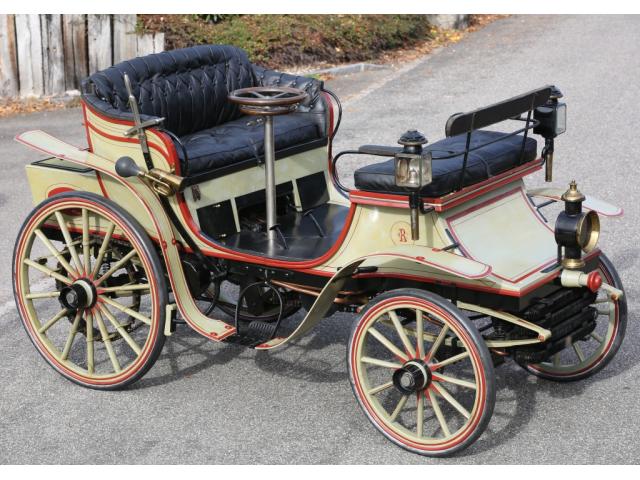1896 Raynaud Vis-à-Vis Prototype
- Brand: Raynaud
1896 Raynaud Vis-à-Vis Prototype
By the mid 1890s the motor fever that began with the Benz Patent Motor Wagen of 1886 was starting to sweep through Europe. There were pioneering forays to latch onto the potential of this future industry from many different angles, bicycle manufacturers frequently had a good line of attack with their existing use of tubed frames as a basis, then there were companies who effectively reduced the proportions of locomotive/steam vehicles to manageable self propelled vehicles, as De Dion, Bouton and Trepardoux did, others experimented with equipping horse drawn carriages with some form of propulsion.
Not surprisingly, the greatest appeal was to those already involved in engineering businesses, to follow the leads of Benz and then Panhard et Levassor, showing that their concepts were the strongest themes. There were also plenty of individuals who simply thought out their own solution to the idea of creating an automatic mobile, a carriage without horses, usually eschewing the contemporary theories and coming up with a completely unique concept. As best anyone has been able to establish, Claude Raynaud was one such person.
Based in Flayosc in the Southern Var region of France, roughly 40 miles inland from Saint Tropez, between Marseille and Cannes, M. Raynaud ran an electric engineering business.
The fascinating car that we present here is Mr. Raynaud's pioneering automobile. Hidden beneath an otherwise quite common form of carriage design for the period, the vis-a-vis, which situated its passengers literally face to face, as opposed to various other configurations of conveyance, is a remarkably and technically very interesting machine, in some ways advanced for its day and perhaps in others already dated. Pertinently, it was powered by two large cylinders traveling individually and horizontally along the insides of the back of a 'C' section frame, the 3.8 litres of engine are transferred to the road through a four speed transmission, controlled by a wheel which sits beneath a steering wheel.
It is almost certain that Mr. Raynaud's vehicle was intended for his own personal use initially and not known whether his plan would have been to have made more of them or marketed a car, no known contemporary literature alludes to such a venture. It is known that he acquired a Rochet-Schneider automobile in 1897, perhaps suggesting that he had already abandoned any thoughts of entering this industry by then.
Claude Raynaud's intriguing automobile is known to have been 'wheeled out' and exhibited in the 1930s, a time when the first flurry of interest in 'old crocks' began, following the first retrospective London to Brighton in 1927. By then it was the property of a notary in Vidauban, just 10 miles from where it was built.
In the 1970s it was acquired by a passionate collector of early vehicles in Switzerland. In his ownership it was presented to the Veteran Car Club of Great Britain Dating Committee in 1977, at which point the Chairman Dennis Field was able to comment that in their opinion 'the vehicle is in completely original condition and is unmodified in any way and contains no replica parts', and given the knowledge of his Rochet Schneider in 1897, 'it seems logical that he was using the Raynaud car during the previous year'. Mr. Field recommended that in the unlikely event of any further information coming to light that the known story be accepted on its face value and that they 'certify the car as 1896'.
Descriptions & pictures by bonhams & wikimedia & flickr & other
| Specification | |
| Production Start | 1896 |
| Country of origin | France |




































